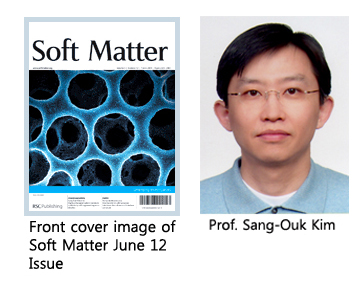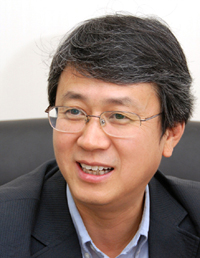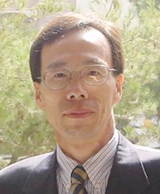chemistry
-
 Artificial Spore Production Technology Developed
The core technology needed in the development of ‘biosensors’ so crucial in diagnosing illnesses or pathogens was developed by Korean research team.
KAIST’s Professor Choi In Seung of the department of Chemistry developed the technology that allows for the production of Artificial Spore by selectively coating a live cell.
In the field of engineering the problem in developing the next generation bio sensor, the cell based sensor, was that it was difficult to keep a cell alive without division for a long time. Once a cell is taken out of the body, it will either divide or die easily.
Professor Choi’s research team mimicked the spore, which has the capability to survive harsh conditions without division, and chemically coated a live cell and artificially created a cell similar to that of a spore.
The physical and biological stabilities of the cell increased by coating an artificial shell over the yeast cell. The shell is composed with a protein similar to that of the protein that gives mussels its stickiness. In addition by controlling the thickness of the shell, the division rate of the yeast can be controlled.
Professor Choi commented that this technology will serve as the basis for the single cell based biosensor.
The research was conducted together with Professor Lee Hae Shin of KAIST department of Chemistry and Professor Jeong Taek Dong of Seoul National University’s department of Chemistry and was published as the cover paper of ‘Journal of the American Chemical Society’.
2011.04.01 View 13304
Artificial Spore Production Technology Developed
The core technology needed in the development of ‘biosensors’ so crucial in diagnosing illnesses or pathogens was developed by Korean research team.
KAIST’s Professor Choi In Seung of the department of Chemistry developed the technology that allows for the production of Artificial Spore by selectively coating a live cell.
In the field of engineering the problem in developing the next generation bio sensor, the cell based sensor, was that it was difficult to keep a cell alive without division for a long time. Once a cell is taken out of the body, it will either divide or die easily.
Professor Choi’s research team mimicked the spore, which has the capability to survive harsh conditions without division, and chemically coated a live cell and artificially created a cell similar to that of a spore.
The physical and biological stabilities of the cell increased by coating an artificial shell over the yeast cell. The shell is composed with a protein similar to that of the protein that gives mussels its stickiness. In addition by controlling the thickness of the shell, the division rate of the yeast can be controlled.
Professor Choi commented that this technology will serve as the basis for the single cell based biosensor.
The research was conducted together with Professor Lee Hae Shin of KAIST department of Chemistry and Professor Jeong Taek Dong of Seoul National University’s department of Chemistry and was published as the cover paper of ‘Journal of the American Chemical Society’.
2011.04.01 View 13304 -
 New Text Book on Chemistry Published by KAIST Professor and Student
A chemistry textbook written in English and Korean will aid Korean students to learn General Chemistry in a global academic setting.
Korean students majoring in chemistry and looking for an opportunity to study abroad will have a new, handy textbook that presents them with a practical introduction to an English speaking lecture on general chemistry.
Aiming for advanced Korean high school and college/university students, the inter-language textbook is written by two incumbent professors teaching chemistry at a university in Korea and the US. The book will help Korean students prepare for a classroom where various topics of general chemistry are presented and discussed in English. Clear, collated sections of English and Korean text provide the student with sufficient explanation of the rudimentary topics and concepts.
Composed of 15 chapters on the core subjects of General Chemistry, i.e., Stoichiometry and Chemical Reactions, Thermochemistry, Atomic Structure, and Bonding, the textbook includes essential English vocabulary and usage sections for each chapter; it also contains a pre-reading study guide on the subject that prepares the student for listening to a lecture. This section includes view-graph type slides, audio files, and follow-up questions the student can use to prepare for an English-speaking course. The various accompanying audio files are prepared to expose the student to English scientific dialogue and serve as examples for instruction at Korean secondary and tertiary schools.
The book was coauthored by Korean and American scientists: A father and son, who have taught chemistry at an American and Korean university, wrote the book. Professor Melvyn R. Churchill at the State University of New York at Buffalo and Professor David G. Churchill at KAIST prepared all of the technical English text which was adapted from General Chemistry course lecture notes; the text was further shaped by original perspectives arising from many student interactions and questions.
This English text was translated into Korean by Professor Kwanhee Lee from the Department of Life and Food Science at Handong Global University, who coauthored a previous preparatory book for Korean students in a different subject. He also supplied an important introductory section which serves as a general guide to the classroom student. Kibong Kim, a doctoral student in the Department of Chemistry at KAIST, helped in preparing the book as well.
“This has been definitely a collaborative undertaking with an international academic crew and it underscores that the Korean internationalization in science is mainstream. Professors and a Korean student created a new book for Korean consumption and benefit,” Professor David G. Churchill says.
----------------------------------------------------------------------------------------
Bibliography: “How to Prepare for General Chemistry Taught in English” by David George Churchill, Melvyn Rowen Churchill, Kwanhee Lee & Kibong Kim, Darakwon Publishing, Paju, Republic of Korea, 2010, 400 pp, ISBN 978-89-5995-730-9 (1 Audio CD included)
2010.04.02 View 15065
New Text Book on Chemistry Published by KAIST Professor and Student
A chemistry textbook written in English and Korean will aid Korean students to learn General Chemistry in a global academic setting.
Korean students majoring in chemistry and looking for an opportunity to study abroad will have a new, handy textbook that presents them with a practical introduction to an English speaking lecture on general chemistry.
Aiming for advanced Korean high school and college/university students, the inter-language textbook is written by two incumbent professors teaching chemistry at a university in Korea and the US. The book will help Korean students prepare for a classroom where various topics of general chemistry are presented and discussed in English. Clear, collated sections of English and Korean text provide the student with sufficient explanation of the rudimentary topics and concepts.
Composed of 15 chapters on the core subjects of General Chemistry, i.e., Stoichiometry and Chemical Reactions, Thermochemistry, Atomic Structure, and Bonding, the textbook includes essential English vocabulary and usage sections for each chapter; it also contains a pre-reading study guide on the subject that prepares the student for listening to a lecture. This section includes view-graph type slides, audio files, and follow-up questions the student can use to prepare for an English-speaking course. The various accompanying audio files are prepared to expose the student to English scientific dialogue and serve as examples for instruction at Korean secondary and tertiary schools.
The book was coauthored by Korean and American scientists: A father and son, who have taught chemistry at an American and Korean university, wrote the book. Professor Melvyn R. Churchill at the State University of New York at Buffalo and Professor David G. Churchill at KAIST prepared all of the technical English text which was adapted from General Chemistry course lecture notes; the text was further shaped by original perspectives arising from many student interactions and questions.
This English text was translated into Korean by Professor Kwanhee Lee from the Department of Life and Food Science at Handong Global University, who coauthored a previous preparatory book for Korean students in a different subject. He also supplied an important introductory section which serves as a general guide to the classroom student. Kibong Kim, a doctoral student in the Department of Chemistry at KAIST, helped in preparing the book as well.
“This has been definitely a collaborative undertaking with an international academic crew and it underscores that the Korean internationalization in science is mainstream. Professors and a Korean student created a new book for Korean consumption and benefit,” Professor David G. Churchill says.
----------------------------------------------------------------------------------------
Bibliography: “How to Prepare for General Chemistry Taught in English” by David George Churchill, Melvyn Rowen Churchill, Kwanhee Lee & Kibong Kim, Darakwon Publishing, Paju, Republic of Korea, 2010, 400 pp, ISBN 978-89-5995-730-9 (1 Audio CD included)
2010.04.02 View 15065 -
 Prof. Sang-Ouk Kim Featured on the Cover of Emerging Investigator Special Issue
KAIST Prof. Sang-Ouk Kim of the Department of Materials Science and Engineering was featured on the cover of the Emerging Investigator Special Issue published by Britain"s Royal Society of Chemistry on June 21, university authorities said on Monday (June 22).
The special issue shed spotlight on 18 up-and-coming scientists who have been selected through the recommendation and rigorous screening process of the editorial and advisory boards of the Royal Society of Chemistry. The 18 scientists consist of six from the American continent, 10 from Europe, one from Japan and one from Korea.
The journal introduced Prof. Kim"s paper, titled "Highly entangled carbon nanotube (CNT) scaffolds by self-organized aqueous droplets." Kim explained in the paper that the cellular CNT demonstrated high electrical conductivity and field-emission properties, which is potentially useful for various applications in electronics and energy storage devices.
2009.06.24 View 13371
Prof. Sang-Ouk Kim Featured on the Cover of Emerging Investigator Special Issue
KAIST Prof. Sang-Ouk Kim of the Department of Materials Science and Engineering was featured on the cover of the Emerging Investigator Special Issue published by Britain"s Royal Society of Chemistry on June 21, university authorities said on Monday (June 22).
The special issue shed spotlight on 18 up-and-coming scientists who have been selected through the recommendation and rigorous screening process of the editorial and advisory boards of the Royal Society of Chemistry. The 18 scientists consist of six from the American continent, 10 from Europe, one from Japan and one from Korea.
The journal introduced Prof. Kim"s paper, titled "Highly entangled carbon nanotube (CNT) scaffolds by self-organized aqueous droplets." Kim explained in the paper that the cellular CNT demonstrated high electrical conductivity and field-emission properties, which is potentially useful for various applications in electronics and energy storage devices.
2009.06.24 View 13371 -
 Method to Synthesize New Lithium Ion Battery Cathode Material Identified
A KAIST research team headed by Prof. Do-Kyung Kim at the Department of Materials Science and Engineering developed a technology to synthesize a new lithium ion battery spinel cathode which is regarded as a core part of hybrid and lithium battery cars.
The research was conducted in collaboration with a research team of Prof. Yi Cui at Stanford University"s Department of Chemistry. Their findings were introduced in the November issue of Nano Letters, one of the leading academic journals in nano-science.
The newly synthesized lithium ion battery spinel cathode known as spinel LiMn2O4 nanorods is attracting interests as an alternative cathode material since it is a low-cost, environmentally friendly substance for Li-ion battery cathodes. Its raw material is also highly available.
Lithium ion batteries with high energy and power density are important for consumer electronic devices, portable power tools, and vehicle electrification. LixCoO2 is a commonly used cathode material in commercial lithium iron batteries. However, the high cost, toxicity, and limited abundance of cobalt have been recognized to be disadvantageous.
2008.11.20 View 13072
Method to Synthesize New Lithium Ion Battery Cathode Material Identified
A KAIST research team headed by Prof. Do-Kyung Kim at the Department of Materials Science and Engineering developed a technology to synthesize a new lithium ion battery spinel cathode which is regarded as a core part of hybrid and lithium battery cars.
The research was conducted in collaboration with a research team of Prof. Yi Cui at Stanford University"s Department of Chemistry. Their findings were introduced in the November issue of Nano Letters, one of the leading academic journals in nano-science.
The newly synthesized lithium ion battery spinel cathode known as spinel LiMn2O4 nanorods is attracting interests as an alternative cathode material since it is a low-cost, environmentally friendly substance for Li-ion battery cathodes. Its raw material is also highly available.
Lithium ion batteries with high energy and power density are important for consumer electronic devices, portable power tools, and vehicle electrification. LixCoO2 is a commonly used cathode material in commercial lithium iron batteries. However, the high cost, toxicity, and limited abundance of cobalt have been recognized to be disadvantageous.
2008.11.20 View 13072 -
 Professor Yang Named Recipient of Dupont Science & Technology Award
Professor Yang Named Recipient of Dupont Science & Technology Award
- Named as the recipient of Dupont Science & Technology Award of 2007- In recognition of his development of optical?bio-functional photonic crystal structures through Self-assembly of nanoparticles
Seung-Man Yang, a professor of Chemical and Biomolecular Engineering of KAIST (President Nam Pyo Suh) and the president of the National Creative Research Initiatives Center for Photon and Fluid Integrated Circuit by the Ministry of Science and Technology, has been named as the recipient of Dupont Science & Technology Award.
Dupont Korea, associate of Dupont, a world-class science firm, has established and conferred ‘Dupont Science & Technology Award’ since 2002 to promote basic sciences and industrial development of Korea. Dupont Science & Technology Awards are awarded to scientists of universities or state-run institutes who have made outstanding R&D achievements in the fields of Chemistry, Chemical Engineering, Material Science and Material Engineering within five years. Dupont Korea announced on May 2, 2007 that Professor Yang is the recipient of the award this year, following the strict examination by the Koran Academy of Science and Technology (KAST).
The reason for the award is Professor Yang’s development of prototype optical?bio-functional photonic crystal structures that can process a huge amount of data, resulting from a study that has discovered the principle of Self-assembly where multifunctional nanoparticles are manufactured and assembled for themselves.
Professor Yang’s recent research result about photon structures and nano patterns was published by Nature (February 2, 2006 edition); posted on Heart-Cut, the portal site of the American Chemistry Society (ACS), as highlight paper two times (November 4, 2002 and May 1, 2006); and introduced at Research/Researcher of MRS Bulletin by the U.S. Material Research Society (MRS) as main paper in December 2003. Professor Yang is very famous in Korea and abroad for the excellences of his research achievements and has made request seminars at Harvard University, University of Wisconsin, Caltech, University of California, etc. He is also invited speaker and session organizer of the MRS and the SPIE.
2007.05.08 View 19281
Professor Yang Named Recipient of Dupont Science & Technology Award
Professor Yang Named Recipient of Dupont Science & Technology Award
- Named as the recipient of Dupont Science & Technology Award of 2007- In recognition of his development of optical?bio-functional photonic crystal structures through Self-assembly of nanoparticles
Seung-Man Yang, a professor of Chemical and Biomolecular Engineering of KAIST (President Nam Pyo Suh) and the president of the National Creative Research Initiatives Center for Photon and Fluid Integrated Circuit by the Ministry of Science and Technology, has been named as the recipient of Dupont Science & Technology Award.
Dupont Korea, associate of Dupont, a world-class science firm, has established and conferred ‘Dupont Science & Technology Award’ since 2002 to promote basic sciences and industrial development of Korea. Dupont Science & Technology Awards are awarded to scientists of universities or state-run institutes who have made outstanding R&D achievements in the fields of Chemistry, Chemical Engineering, Material Science and Material Engineering within five years. Dupont Korea announced on May 2, 2007 that Professor Yang is the recipient of the award this year, following the strict examination by the Koran Academy of Science and Technology (KAST).
The reason for the award is Professor Yang’s development of prototype optical?bio-functional photonic crystal structures that can process a huge amount of data, resulting from a study that has discovered the principle of Self-assembly where multifunctional nanoparticles are manufactured and assembled for themselves.
Professor Yang’s recent research result about photon structures and nano patterns was published by Nature (February 2, 2006 edition); posted on Heart-Cut, the portal site of the American Chemistry Society (ACS), as highlight paper two times (November 4, 2002 and May 1, 2006); and introduced at Research/Researcher of MRS Bulletin by the U.S. Material Research Society (MRS) as main paper in December 2003. Professor Yang is very famous in Korea and abroad for the excellences of his research achievements and has made request seminars at Harvard University, University of Wisconsin, Caltech, University of California, etc. He is also invited speaker and session organizer of the MRS and the SPIE.
2007.05.08 View 19281